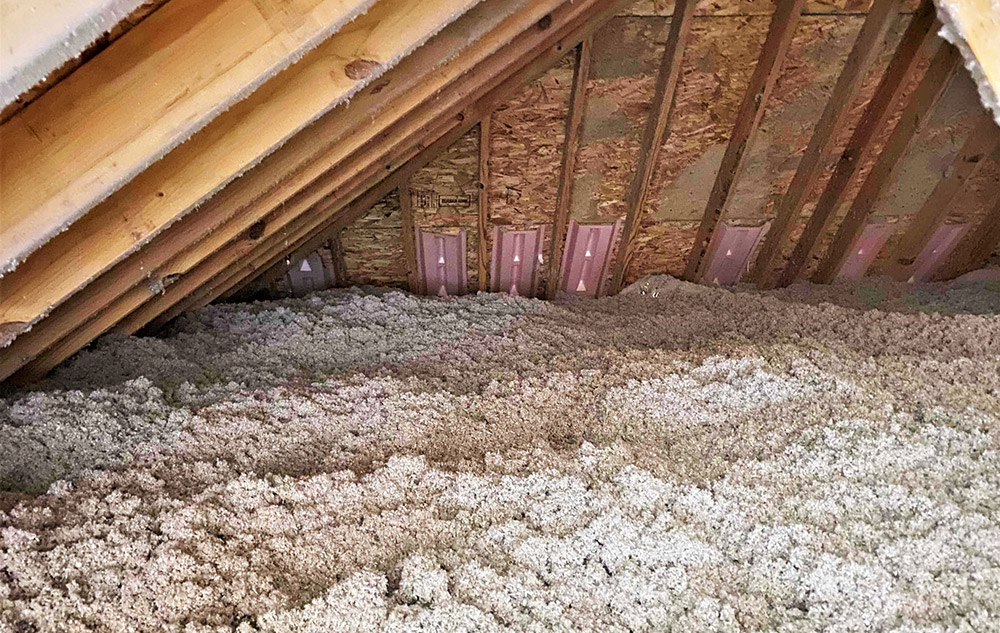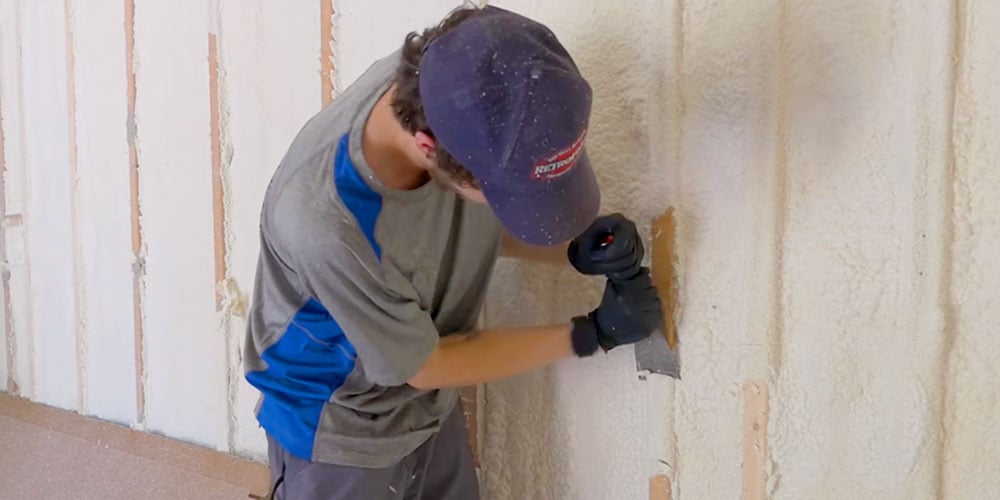How Spray Foam Can Improve Power Efficiency in Any Type Of Structure
Spray foam insulation has arised as a pivotal service for boosting energy effectiveness throughout various building kinds. By producing an airtight seal that lessens air leak, it effectively controls interior environments while considerably minimizing cooling and heating expenses. Moreover, its remarkable R-value and moisture-resistant buildings contribute to long-term energy cost savings and boosted structure longevity. As homeowner increasingly seek sustainable services, the ramifications of spray foam insulation expand past plain utility savings. The full scope of its benefits, however, warrants a better assessment of exactly how it can change power monitoring methods in both property and business settings.
Understanding Spray Foam Insulation
Spray foam insulation is significantly acknowledged for its exceptional thermal performance and versatility in numerous applications. Composed mainly of polyurethane, this insulation product is used as a liquid that expands upon call, filling up gaps and creating a smooth obstacle. This one-of-a-kind property permits spray foam to comply with irregular surfaces, making it a suitable option for both property and commercial structures.

Application of spray foam insulation is typically executed by qualified specialists making use of specialized devices, ensuring ideal efficiency and safety and security - Spray Foam. The curing process is quick, enabling quick installment and minimal disruption. Consequently, spray foam insulation is increasingly being utilized in new building and retrofitting tasks due to its capability to boost structural stability while boosting overall energy effectiveness in buildings
Benefits of Energy Efficiency
Power performance plays a crucial function in lowering operational prices and decreasing ecological effect across numerous fields. By enhancing energy usage, organizations and home owners can achieve significant financial savings on utility bills, which straight improves financial efficiency. Efficient power usage implies much less dependence on fossil fuels, therefore adding to a reduction in greenhouse gas exhausts and advertising a more lasting atmosphere.
Furthermore, energy-efficient buildings often experience raised residential or commercial property values. As power expenses increase and sustainability becomes a priority for customers, homes with improved energy efficiency features are much more attractive on the market. This pattern urges investment in energy-saving technologies, which can even more drive advancement and financial growth.
In addition to environmental and monetary benefits, power efficiency can additionally improve the total comfort and wellness of indoor rooms. Proper insulation and efficient cooling and heating systems aid preserve consistent temperature levels, reducing drafts and moisture levels, which consequently can lead to far better indoor air top quality.
Eventually, the advantages of power efficiency prolong past immediate cost savings, fostering a resilient economic climate, advertising ecological stewardship, and improving the lifestyle for passengers in any building.
Exactly How Spray Foam Functions
Usually applied as a liquid, spray foam expands quickly upon contact with surfaces, developing a solid barrier that efficiently seals fractures and spaces. This one-of-a-kind residential or commercial property is because of its chemical structure, mostly being composed of polyols and isocyanates, which respond when blended to develop a foam that fills voids and adheres to different products, consisting of metal, wood, and concrete.
Once applied, the foam increases to numerous times its initial volume, making sure a tight seal that prevents air leak. This procedure significantly reduces thermal bridging, which takes place when warm transfers with materials, leading to power loss. The foam's high R-value, a procedure of thermal resistance, contributes to improved insulation by minimizing warmth transfer between the interior and exterior environments.
Furthermore, spray foam is resistant to moisture and bugs, better redirected here boosting its efficiency in maintaining energy efficiency. Its application can be tailored to various areas, including attic rooms, wall surfaces, and crawl spaces, maximizing insulation across a structure. Spray Foam. In general, the innovative design and application method of spray foam make it an effective service for enhancing power effectiveness in any framework, leading to minimized energy expenses and a more sustainable constructed environment

Applications in Various Buildings
Countless applications of spray foam insulation can be found across different structure kinds, enhancing energy effectiveness and convenience. In residential homes, spray foam is typically made use of in walls and attics to produce a smooth obstacle against air leaks, considerably lowering home heating and cooling down demands. This application is particularly helpful in older homes, where typical insulation might be inadequate.
In commercial buildings, spray foam insulation is applied to roofing systems and outside wall surfaces, which aids to boost thermal efficiency and shield versus moisture intrusion. Its light-weight nature makes it a perfect choice for retrofitting existing structures without adding considerable weight. Furthermore, spray foam can be utilized in industrial settings to insulate pipes and storage tanks, maintaining temperature level control for delicate products.
Institutional structures, such as hospitals and schools, take advantage of spray foam insulation by guaranteeing a constant indoor climate that supports occupant convenience and health. The versatility of spray foam allows it to adapt to various building sizes and shapes, making it a favored option for architects and contractors looking for reliable insulation remedies. Generally, spray foam insulation works as an essential component in attaining energy-efficient buildings throughout all sectors.
Long-Term Expense Savings
Spray foam insulation provides useful site considerable long-lasting expense savings for structure owners and owners by lowering energy intake and reducing energy expenses. By providing a premium air seal, spray foam lessens the infiltration of outdoors air, thereby boosting the thermal performance of a structure. This results in extra effective home heating and cooling procedures, which can result in significant reductions in power costs gradually.
In addition to prompt savings on energy bills, the toughness and longevity of spray foam insulation add to its financial advantages. Unlike typical insulation materials, which might droop, work out, or wear away, spray foam maintains its performance for decades, minimizing the demand for frequent replacements or fixings. This longevity equates to reduce upkeep costs and less interruption for owners.
Additionally, structures equipped with spray foam insulation commonly appreciate an increase in building value, making them much more attractive to possible customers or tenants. As energy efficiency ends up being progressively prioritized, residential or commercial properties with efficient insulation options attract attention on the market. Eventually, the combination of spray foam insulation not only improves comfort but also represents a tactical investment that yields significant financial benefits over the long-term.
Conclusion
In conclusion, spray foam insulation offers as an important element in improving energy effectiveness throughout diverse building kinds. Its ability to create a seamless obstacle versus air leakage, integrated with moisture-resistant properties and high r-values, considerably lowers power intake and linked expenses. The application of spray foam blog here not only adds to regular indoor temperatures but also raises residential or commercial property worth, highlighting its role as a sensible financial investment for both industrial and domestic residential or commercial properties.
Spray foam insulation has actually emerged as a pivotal option for enhancing power effectiveness throughout different structure types. Spray Foam. As an outcome, spray foam insulation is progressively being used in new construction and retrofitting jobs due to its ability to improve architectural stability while boosting general power efficiency in structures
Overall, the cutting-edge design and application technique of spray foam make it a reliable service for boosting energy effectiveness in any kind of structure, leading to lowered energy expenses and an extra sustainable developed setting.
Various applications of spray foam insulation can be discovered throughout various structure kinds, enhancing power efficiency and comfort.In verdict, spray foam insulation offers as an important element in boosting energy effectiveness throughout varied structure types.